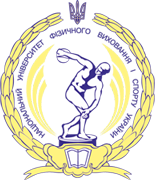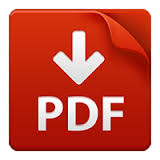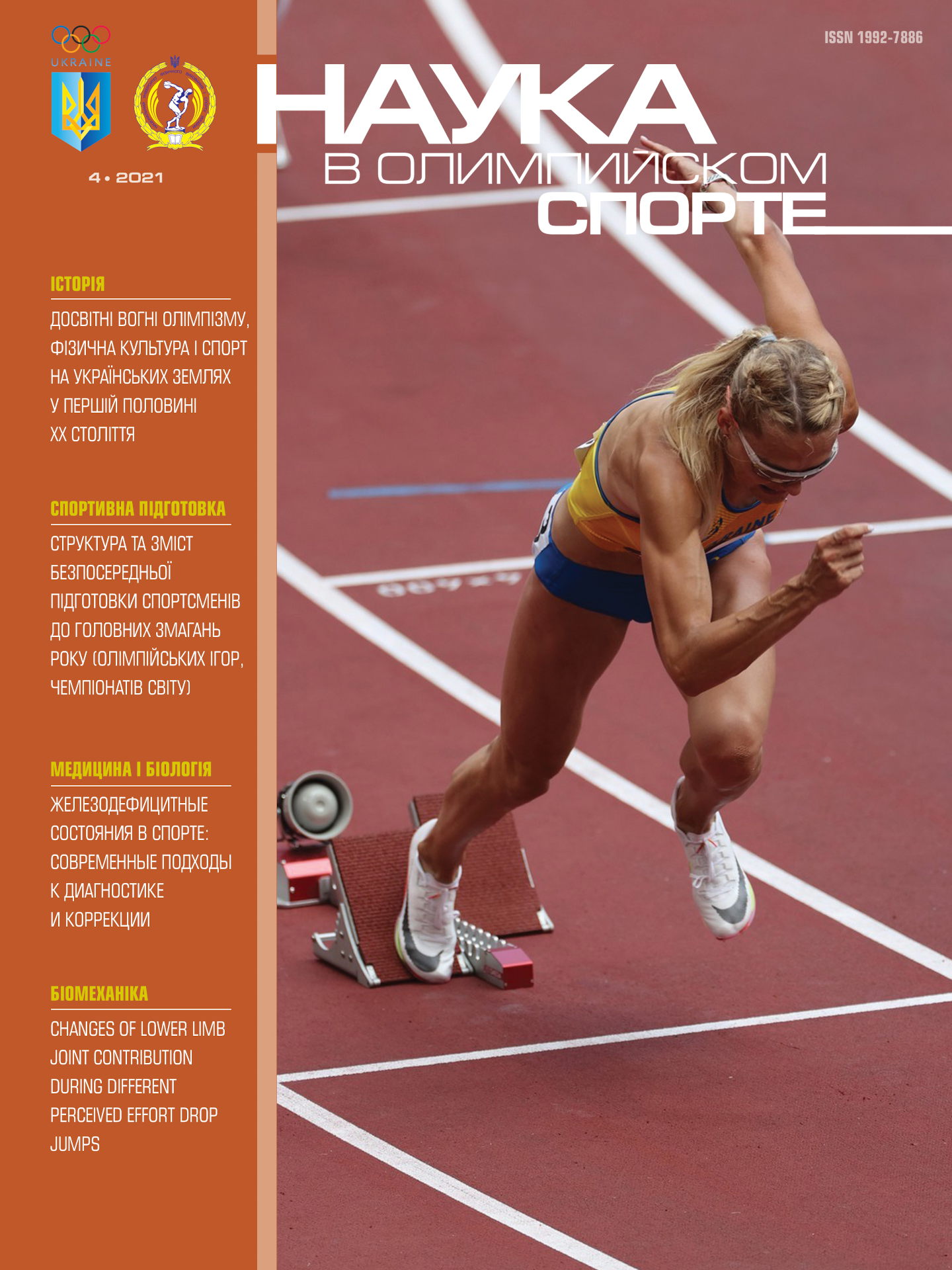doi: 10.32652/olympic2020.4_6
Objective. Based on the analysis of scientific literature and generalization of own findings in representatives of Olympic sports events to form modern ideas about the role of serum iron, as well as the parameters of its metabolism in the body, in maintaining general and special (aerobic) physical work capacity of highly skilled athletes. Methods. Analysis and synthesis of data from scientific and methodological literature; laboratory and diagnostic, statistical. Results. Based on the analysis of literature data and the results of practical work of the authors, the modern ideas about the role of iron in the formation and maintenance of general physical work capacity and aerobic performance in the representatives of various Olympic sports events have been formed. Based on the analysis of cohort studies of highly skilled athletes, a complex time tested algorithm for diagnosing «latent iron deficiency» and «iron deficiency anemia» is presented, as well as a set of screening laboratory indices of iron metabolism and transport during monitoring athletes in the dynamics of the training process. Conclusion. Thus, the iron content in the body of athletes, which is marked by its level in blood serum, is largely responsible for adequate oxygen transport function of the blood, as well as general and special (aerobic) work capacity. The informative assessment of iron content necessitates investigating the factors that ensure the metabolism of this macronutrient in the body. A complex assessment of laboratory parameters of iron content and metabolism should be a mandatory component of medico-biological control, especially in cyclic sports events.
Literature
1. Vdovenko NV, Ivanova AM, Loshkarʹova YEO. Praktychni rekomendatsiyi shchodo profilaktyky ta korektsiyi defitsytu zaliza v orhanizmi sport·smeniv [Practical recommendations on prevention and correction of iron deficiency in the body of athletes]. Pedahohika, psykholohiya ta medyko-biolohichni problemy fizychnoho vykhovannya i sportu. 2015;(1): 12-6.
2. Vynnychuk YUD, Hunyna LM. Dyahnostyka narushenyy obmena zheleza y érytrotsytarnykh kharakterystyk u sport·smenok pry fyzycheskykh nahruzkakh [Diagnosis of iron metabolism and erythrocytic disorders in female athletes under physical loads]. Laboratorna diahnostyka. 2016;(4): 17-22.
3. Hadzhyeva SR, Alyeva TY, Abdullaev RA, Velyeva ZT, Ysaeva NM, y soavt. Byolohycheskoe znachenye zheleza [Biological significance of iron]. Molodoy uchenyy. 2015;4(84): 34-6.
4. Hyshchak TV, Horchakova NA, Hunyna LM, Oleynyk SA, Seyfulla RD. Sportyvnaya farmakolohyya y dyetolohyya [Sports pharmacology and dietology]; pod red. Oleynyka SA, Hunynoy LM. Moskva-SPb-Kyev: Dyalektyka, «YD Vylʹyams»; 2008. 249 s.
5. Hunina LM, Tkachova DL. Suchasni laboratorni kryteriyi v systemi medyko-biolohichnoho kontrolyu sport·smena: neobkhidniy ta dostatniy perelik [Modern laboratory criteria in the system of athlete medico-biological control: necessary and sufficient list]. Sportyvna medytsyna. 2012;(1): 110-7.
6. Hunina LM. Erytrotsyty za okysnoho stresu pry fizychnykh navantazhennyakh (ohlyad literatury) [Erythrocytes under oxidative stress during exercise (literature review)]. Perspektyvy medytsyny ta biolohiyi. 2013;V(1): 7-13.
7. Hunina LM. Mekhanizmy realizatsiyi erhohennykh vlastyvostey antyoksydantnykh zasobiv za intensyvnykh fizychnykh navantazhenʹ u kvalifikovanykh sport·smeniv [Realization mechanism of ergogenic capacities of antioxidant means in skilled athletes under intensive physical loads]. Dys … doktora biolohichnykh nauk: spetsialʹnistʹ 14.03.04 – patolohichna fiziolohiya. Luhansʹkyy medychnyy un-t, Rubizhne, 2015. 486 s.
8. Hunina LM. Rolʹ profilaktyky ta korektsiyi funktsionalʹnoyi anemiyi u pidvyshchenni fizychnoyi pratsezdatnosti sport·smeniv [The role of functional anemia prevention and correction in the improvement of athletesʺ physical work capacity]. Fiziolohichnyy zhurnal. 2007;53(4): 91–97.
9. Hunina LM. Unifikovana prohrama pohlyblenoho medyko-biolohichnoho obstezhennya sport·smeniv zbirnykh komand Ukrayiny ta yikh nayblyzhchoho rezervu [Unified program of in-depth medico-biological examination of athletes of national teams of Ukraine and their nearest reserve]. (proekt). Sportyvna medytsyna. 2009;(1-2): 151-4.
10. Huseva SA, Honcharov YAP. Anemyy [Anemias] . Kyev, Lohos, 2004; C. 370.371.
11. Dmytryev AV, Hunyna LM. Sportyvnaya nutrytsyolohyya [Sports nutritiology ]. Moskva: «Sport»; 2020a. 639 s.
12. Durmanov ND, Fylymonov AS. Dyahnostyka y korrektsyya narushenyy obmena zheleza v sporte vysshykh dostryzhenyy [Diagnosis and correction if iron metabolism disorders in elite sport]. Metodycheskye rekomendatsyy dlya vrachey klubov. Moskva; 2010. 84 s.
13. Yordanskaya FA, Tsepkova NK, Kryazheva SV. Dyahnostycheskoe y prohnostycheskoe znachenye mykroélementov krovy v monytorynhe funktsyonalʹnoy podhotovlennosty vysokokvalyfytsyrovannykh sport·smenov. Nauchno-metodycheskoe posobye. Moskva, OOO «Skayprynt», 2013. 112 s.
14. Kochetkova NY, Tsepkova NK, Yordanskaya FA. Zhelezo krovy: dyahnostycheskoe y prohnostycheskoe znachenye v monytorynhe funktsyonalʹnoho sostoyanyya vysokokvalyfytsyrovannykh sport·smenok [Blood serum: diagnostic and prognostic significance in monitoring functional state of highly skilled female athletes]. Vestnyk sportyvnoy nauky. 2012; 4(4): 27-34.
15. Makarova HA, Kholyavko YUA, Verlyna HV. Klynyko-laboratornoe obsledovanye sport·smenov vysshey kvalyfykatsyy: osnovnye napravlenyya sovershenstvovanyya [Clinical and laboratory examination of elite athletes: the main directions of improvement]. Lechebnaya fyzkulʹtura y sportyvnaya medytsyna. 2013;7(115): 4-12.
16. Makarova HA, Kholyavko YUA. Laboratornye pokazately v praktyke sportyvnoho vracha: Spravochnoe rukovodstvo [Laboratory indices in the practice of sports physician. Data manual]. Moskva: Sov. sport; 2006. 199 s.
17. Makarova HA. Dyahnostycheskyy potentsyal kartyny krovy u sport·smenov [Diagnostic potential of blood picture in athletes]. Moskva: «Sport»; 2020. 256 s.
18. Marhazyn VA, Noskova AS. Anemyya u sport·smenov [Anemia in athletes]. Lechebnaya fyzkulʹtura y sportyvnaya medytsyna. 2010;5(77): 27-32.
19. Mykhaylyk OM, Dudchenko NO, Lubyanova IP. Pokaznyky obminu nehemovoho zaliza v orhanizmi zdorovykh doroslykh lyudey [Indices of nonheme iron in the body of healthy adults]. Sovremennye problemy toksykolohyy. 2002;(1): 83-94.
20. Platonov VN. Dvyhatelʹnye kachestva y fyzycheskaya podhotovka sport·smenov [Motor qualities and physical preparation of athletes]. Kyev: Olymp. lyt., 2017a: 222.322, 488-491.
21. Platonov VN. Dvyhatelʹnye kachestva y fyzycheskaya podhotovka sport·smenov [Motor qualities and physical preparation of athletes ]. Kyev, Olymp. lyt., 2017b: 535-63.
22. Seredyntseva NV. Vlyyanye produktov pchelovodstva na pokazately kyslorodtransportnoy funktsyy krovy [Influence of beekeeping products on indices of blood oxygen transport function]. Uchenyye zapiski universiteta imeni P.F. Lesgafta. 2012;90(8): 76-80.
23. Solodkov AS, Sologub YEB. Fiziologiya sporta: uchebnoye posobiye [Sports physiology: teaching guide]. SPb, Izd-vo SPbGAFK imeni P. F. Lesgafta; 1999. 231 s.
24. Shakhlina LYA-G, Vovchanytsya YUL, Tereshchenko TA. Zhelezodefitsitnyye sostoyaniya u zhenshchin v praktike sporta vysshikh dostizheniy [Iron deficiency states in females in the practice of elite sport]. Sportivnaya meditsina. 2013;(2): 27-33.
25. Ahmadi A, Enayatizadeh N, Akbarzadeh M, Asadi S, Tabatabaee SH, et al. Iron status in female athletes participating in team ball-sports. Pak J Biol Sci. 2010;15(13, Suppl 2): 93-6. doi: 10.3923/pjbs.2010.93.96.
26. Alaunyte I, Stojceska V, Plunkett A. Iron and the female athlete: a review of dietary treatment methods for improving iron status and exercise performance. J Int Soc Sports Nutr. 2015;12: 38. doi: 10.1186/s12970-015-0099-2. eCollection 2015.
27. Albrektsen G, Bonaa KH. Body Iron Stores and the Gender Gap in Risk of Incident Myocardial Infarction-Reply. JAMA Intern Med. 2017;177(4):595-6. doi: 10.1001/jamainternmed.2016.9675.
28. Anand IS, Gupta P. Anemia and Iron Deficiency in Heart Failure: Current Concepts and Emerging Therapies. Circulation. 2018;138(1): 80-98. doi: 10.1161/CIRCULATIONAHA.118.030099.
29. Andrews JR. Current concepts in sports medicine: the use of COX-2 specific inhibitors and the emerging trends in arthroscopic surgery. Orthopedics. 2000l;23(7 Suppl):S769-72.
30. Brumitt J, Mclntosh L, Rutt R. Comprehensive sport medicine treatment of an athlete who runs cross-country and is iron deficient. N Am J Sports Phys Ther. 2009;4(1): 13-20.
31. Burden RJ, Pollock N, Whyte GP, Richards T, Moore B, et al. Effect of Intravenous Iron on Aerobic Capacity and Iron Metabolism in Elite Athletes. Med Sci Sports Exerc. 2015;47(7): 1399.1407. doi: 10.1249/MSS.0000000000000568.
32. Camaschella C, Pagani A, Nai A, Silvestri L. The mutual control of iron and erythropoiesis. Int J Lab Hematol. 2016;38(Suppl 1): 20-6. doi: 10.1111/ijlh.12505.
33. Clenin GE. The treatment of iron deficiency without anaemia (in otherwise healthy persons). Swiss Med Wkly. 2017;147: w14434. doi: 10.4414/smw.2017.14434.
34. Clenin GE, Cordes M. [Laboratory analyses in sports medicine]. Ther Umsch. 2015;72(5): 311-9. doi: 10.1024/0040-5930/a000681.
35. Clenin G, Cordes M, Huber A, Schumacher YO, Noack P, et al. Iron deficiency in sports – definition, influence on performance and therapy. Swiss Med Wkly. 2015;145: w14196. doi: 10.4414/smw.2015.14196.
36. Coates A, Mountjoy M, Incidence of Iron Deficiency and Iron Deficient Anemia in Elite Runners and Triathletes. Burr J. Clin J Sport Med. 2017;27(5): 493-8. doi: 10.1097/JSM.0000000000000390.
37. Conrad M, Kagan VE, Bayir H, Pagnussat GC, Head B, et al. Regulation of lipid peroxidation and ferroptosis in diverse species. Genes Dev. 2018;32(9-10): 602-9. doi: 10.1101/gad.314674.118.
38. Danielsson T, Carlsson J, Siethoff LT, Ahnesjo J, Bergman P. Aerobic capacity predict skeletal but not cardiac muscle damage after triathlon - the Iron(WO)man study. Sci Rep. 2020;10(1): 901. doi: 10.1038/s41598-020-57842-w.
39. DellaValle DM. Iron supplementation for female athletes: effects on iron status and performance outcomes. Curr Sports Med Rep. 2013;12(4): 234.239. doi: 10.1249/JSR.0b013e31829a6f6b.
40. Fuqua BK, Vulpe CD, Anderson GJ. Iron in the diet is found in a wide variety of forms, but the absorption of non-heme iron is best understood. J Trace Elem Med Biol. 2012;26(2-3): 115-9. doi: 10.1016/j.jtemb.2012.03.015.
41. Gammella E, Buratti P, Cairo G, Recalcati S. The transferrin receptor: the cellular iron gate. Metallomics. 2017;9(10): 1367-75. doi: 10.1039/c7mt00143f.
42. Gulec S, Anderson GJ, Collins JF. Mechanistic and regulatory aspects of intestinal iron absorption. Am J Physiol Gastrointest Liver Physiol. 2014;307(4): G397.409. doi: 10.1152/ajpgi.00348.2013.
43. Haas JD, Brownlie T-4th. Iron deficiency and reduced work capacity: a critical review of the research to determine a causal relationship. J Nutr. 2001;131(2S-2): 676S.688S; discussion 688S-690S. doi: 10.1093/jn/131.2.676S.
44. Hinton PS. Iron and the endurance athlete. Appl Physiol Nutr Metab. 2014;39(9): 1012-18. doi: 10.1139/apnm-2014-0147.
45. Houston BL, Hurrie D, Graham J, Perija B, Rimmer E, et al. Efficacy of iron supplementation on fatigue and physical capacity in non-anaemic iron-deficient adults: a systematic review of randomised controlled trials. BMJ Open. 2018;8(4): e019240. doi: 10.1136/bmjopen-2017-019240.
46. Janakiraman K, Shenoy S, Sandhu JS. Intravascular haemolysis during prolonged running on asphalt and natural grass in long and middle distance runners. J Sports Sci. 2011;29: 1287-92. doi: 10.1080/02640414.2011.591416.
47. Kempe DS, Lang PA, Duranton C, Akel A, Lang KS, et al. Enhanced programmed cell death of iron-deficient erythrocytes. FASEB J. 2006;20(2): 368-70. doi: 10.1096/fj.05-4872fje.
48. Koury MJ, Ponka P. New insights into erythropoiesis: the roles of folate, vitamin B12, and iron. Annu Rev Nutr. 2004;24: 105-1. doi: 10.1146/annurev.nutr.24.012003.132306.
49. Lippi G, Brocco G, Franchini M, Schena F, Guidi GC. Comparison of serum creatinine, uric acid, albumin and glucose in male professional endurance athletes compared with healthy controls. Clin Chem Lab Med. 2004;42(6): 644-7. doi: 10.1515/CCLM.2004.110.
50. Liu C, Wang R, Zhang B, Hu C. Protective effects of lycopene on oxidative stress, proliferation and autophagy in iron supplementation rats. Biol. Res. 2013;46(2): 189-200.
51. Liu J, Tan Y, Yang B, Wu Y, Fan B, et al. Polychlorinated biphenyl quinone induces hepatocytes iron overload through up-regulating hepcidin expression. Environ Int. 2020; Apr 8: 139: 105701. doi: 10.1016/j.envint.2020.105701.
52. Malczewska J, Raczynski G, Stupnicki R. Iron status in female endurance athletes and in non-athletes. Int J Sport Nutr Exerc Metab. 2020;10(3): 260-76.
53. Martin-Ontiyuelo C, Rodo-Pin A, Sancho-Munoz A, Martinez-Llorens JM, Admetllo M, et al. Is iron deficiency modulating physical activity in COPD? Int J Chron Obstruct Pulmon Dis. 2019;14: 211-14. doi: 10.2147/COPD.S182700. eCollection 2019.
54. McClung JP. Iron, Zinc, and Physical Performance. Biol Trace Elem Res. 2019;188(1): 135-9. doi: 10.1007/s12011-018-1479-7.
55. Moreno-Fernandez J, Ochoa JJ, Latunde-Dada GO, Diaz-Castro J. Iron Deficiency and Iron Homeostasis in Low Birth Weight Preterm Infants: A Systematic Review. Nutrients. 2019;11(5): 1090. doi: 10.3390/nu11051090.
56. Munoz M, Gomez-Ramirez S, Besser M, Pavia J, Gomollon F, et al. Current misconceptions in diagnosis and management of iron deficiency. Blood Transfus. 2017;15(5): 422-37. doi: 10.2450/2017.0113-17.
57. Musallam KM, Taher AT. Iron deficiency beyond erythropoiesis: should we be concerned? Curr Med Res Opin. 2018;34(1): 81-93. doi: 10.1080/03007995.2017.1394833.
58. Nowak A, Angelillo-Scherrer A, Betticher D, Dickenmann M, Guessous I, et al. Swiss Delphi study on iron deficiency. Swiss Med Wkly. 2019;149: w20097. doi: 10.4414/smw.2019.20097. eCollection 2019.
59. Parmar JH, Mendes P. A computational model to understand mouse iron physiology and disease. PLoS Comput Biol. 2019;15(1): e1006680. doi: 10.1371/journal.pcbi.1006680. eCollection 2019 Jan.
60. Pedlar CR, Brugnara C, Bruinvels G, Burden R. Iron balance and iron supplementation for the female athlete: A practical approach. Eur J Sport Sci. 2018;18(2): 295-305. doi: 10.1080/17461391.2017.1416178.
61. Portal S, Epstein M, Dubnov G. Iron deficiency and anemia in female athletes – causes and risks. Harefuah. 2003;142(10): 698-03, 717.
62. Robinson Y, Cristancho E, Boning D. Intravascular hemolysis and mean red blood cell age in athletes. Med Sci Sports Exerc. 2006;38(3): 480-83. doi: 10.21037/atm.2019.05.41.
63. Rodenberg RE, Gustafson S. Iron as an ergogenic aid: ironclad evidence? Curr Sports Med Rep. 2007;6(4): 258-64.
64. Saneela S, Iqbal R, Raza A, Qamar MF. Hepcidin: A key regulator of iron. J Pak Med Assoc. 2019;69(8): 1170.11-75. PMID: 31431773.
65. Sim M, Garvican-Lewis LA, Cox GR, Govus A, McKay AKA, et al. Iron considerations for the athlete: a narrative review. Eur J Appl Physiol. 2019;119(7): 1463-78. doi: 10.1007/s00421-019-04157-y.
66. Soppi ET. Iron deficiency without anemia . a clinical challenge. Clin Case Rep. 2018;6(6): 1082-86. doi: 10.1002/ccr3.1529. eCollection 2018.
67. Stoffel NU, Cercamondi CI, Brittenham G, Zeder C, Geurts-Moespot AJ, et al. Iron absorption from oral iron supplements given on consecutive versus alternate days and as single morning doses versus twice-daily split dosing in iron-depleted women: two open-label, randomised controlled trials. Lancet Haematol. 2017;4(11): e524. e533. doi: 10.1016/S2352-3026(17)30182-5.
68. von Haehling S, Ebner N, Evertz R, Ponikowski P, Anker SD. Iron Deficiency in Heart Failure: An Overview. JACC Heart Fail. 2019;7(1): 36-6. doi: 10.1016/j.jchf.2018.07.015.
69. Wang Z, Yin W, Zhu L, Li J, Yao Y, et al. Iron Drives T Helper Cell Pathogenicity by Promoting RNA-Binding Protein PCBP1-Mediated Proinflammatory Cytokine Production. Immunity. 2018;49(1): 80.92.e7. doi: 10.1016/j.immuni.2018.05.008.
70. Zhang W, Lv T, Huang J, Ou X. Type 4B hereditary hemochromatosis associated with a novel mutation in the SLC40A1 gene: A case report and a review of the literature. Medicine (Baltimore). 2017;96(38): e8064. doi: 10.1097/MD.0000000000008064.
71. Zheng QQ, Zhao YS, Guo J, Zhao SD, Song LX, et al. Iron overload promotes erythroid apoptosis through regulating HIF-1a/ROS signaling pathway in patients with myelodysplastic syndrome. Leuk Res. 2017l;58: 55.62. doi: 10.1016/j.leukres.2017.04.005.
72. https://dila.ua/rus/labdir/291.html.
Received: 20.12.2020
doi: 10.32652/olympic2020.4_6
В статье сформированы современные представления о тонких механизмах обмена и транспорта железа и роли его недостатка в ухудшении аэробной продуктивности спортсменов. Для информативной оценки содержания железа в организме необходимо исследовать все факторы, обеспечивающие метаболизм данного макроэлемента в организме.













